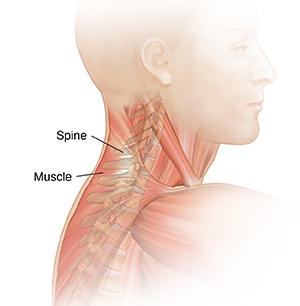Understanding Cervical Strain
There are seven bones (vertebrae) in the neck that are part of the spine. These are called the cervical spine. Cervical strain is a medical term for neck pain. The neck has several layers of muscles. These are connected with tendons to the cervical spine and other bones. Neck pain is often the result of injury to these muscles and tendons.

Causes of cervical strain
Different types of stress on the neck can damage muscles and tendons (soft tissues) and cause cervical strain. Cervical tissues can be damaged by:
-
The neck being forced past its normal range of motion, such as in a car accident or sports injury
-
Constant, low-level stress, such as from poor posture or a poorly set up workspace
Symptoms of cervical strain
These may include:
-
Neck pain or stiffness
-
Pain in the shoulders or upper back
-
Muscle spasms
-
Headache, often starting at the base of the neck
-
Irritability, trouble concentrating, or sleeplessness
-
Numbness in the arm or hand
-
Tingling or weakness in the arm
Treatment for cervical strain
This problem often gets better on its own. Treatments aim to reduce pain and inflammation and increase the range of motion of the neck. Possible treatments include:
-
Changes to your posture or sleep positions. This can help ease muscle tension.
-
Over-the-counter or prescription medicine. These help relieve pain and inflammation.
-
Muscle relaxant can help with muscle spasms.
-
Stretching exercises to decrease neck stiffness.
-
Massage to decrease neck stiffness.
-
Cold or heat pack. These help reduce pain and swelling.
Call 911
Call 911 right away if you have any of these:
-
Face drooping or numbness
-
Numbness or weakness, especially in the arms or on one side
-
Slurred speech or difficulty speaking
-
Blurred vision
When to call your healthcare provider
Call your healthcare provider right away if you have any of these:
-
Fever of 100.4°F (38°C) or higher, or as directed by your provider
-
Chills
-
Pain or stiffness that gets worse
-
Symptoms that don’t get better, or get worse
-
Numbness, tingling, weakness or shooting pains into the arms or legs
-
New symptoms
© 2000-2024 The StayWell Company, LLC. All rights reserved. This information is not intended as a substitute for professional medical care. Always follow your healthcare professional's instructions.